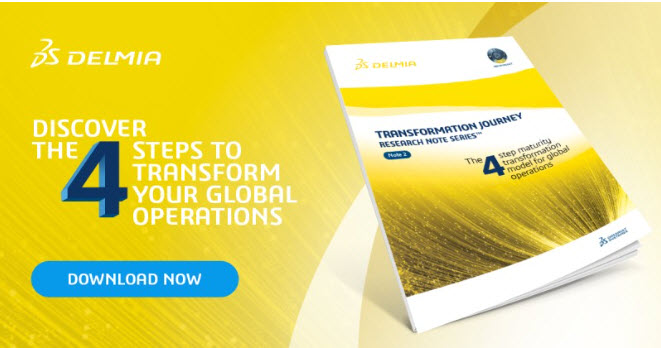The 4-Step Maturity Transformation Model for Operations
Blog: Apriso Blog

DELMIA Podcast Series on the Transformation Journey

This is the second blog on a series of podcasts that discuss enterprise transformation called the “Transformation Journey: Research Note Series.”
Note #1| The 7 Components to Transforming Operations kicked off the series with critical information on the 7 core digital technology components needed to deliver flexibility, resiliency, and improved performance in manufacturing and operations.
This podcast series continues with Note #2 | The 4 Step Maturity Transformation Model for Operations. It features Eric Green, Vice President, DELMIA and Fred Thomas, Strategic Business Development and Marketing Director at DELMIA.
Here you will learn more about the transformation journey. Discover the ability to assess your status and maturity level at each of these four steps individually, which is critical to a successful transformation. Leading with the maturity model topic, Fred jumps right in with the question “What exactly is the maturity model?” As Eric explains, different elements of manufacturing transformation (also referred to as digital or industrial transformation) have different elements associated with it. Another aspect of the transformation journey are the maturity models.
The maturity models reflect the state of most organizations with regard to business, business processes and structure. In Note 2, the focus is on the effect and relationship between maturity models and transformation.
In this part of the series, there is a section on self-assessment. In fact, the place to start is with a very straightforward process, as Eric discusses in the podcast. For example, a company needs to look at their IT process, OT process (Operational Technology) and the state of the organization. The goal is to be engaged in order to leverage the seven components of maturity to determine where to start and where to evolve.
In the first part of the Note 2 podcast, Eric states that for each maturity level, three self-assessment questions will be provided to help determine if a business has achieved this level of maturity. In the end, organizations will realize the benefits and for those with multiple locations, it spreads across the organization’s network.
Interested in learning more? See details below on where to access additional information.
Where to Find More Information
Listen to our DELMIA “Global Operations on the Go” podcast to learn more about the key components of the Transformation Journey.

For details, download your copy of “Transformation Journey Research Note Series: A 4-steps guide to drive your industrial transformation journey.”
This podcast series continues next with Frederique Bourdoulous as she joins the conversation with the second part of Note #2 | The 4 Step Maturity Transformation Model for Operations. Look for details in our upcoming DELMIA blog.
Leave a Comment
You must be logged in to post a comment.








